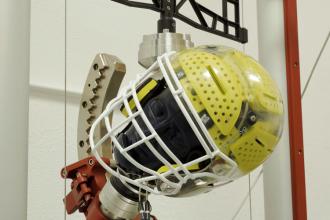As a neurologist, Robert Knight has seen what happens when the brain crashes around violently inside the skull. And he’s aware of the often tragic consequences.
Throughout his 40 years as an academic researcher and medical doctor, the University of California, Berkeley, professor of psychology and neuroscience has known students and friends whose lives and careers were derailed by head injuries from bicycle and car crashes. He’s held in his hands brains destroyed by accidental blows to the head.
Not surprisingly, he cringes when he imagines his young grandchildren falling off a bike and hitting their heads.
So, Knight invented a better helmet — one with more effective padding to dampen the effects of a direct hit, but more importantly, an innovative outer shell that rotates to absorb twisting forces that today’s helmets don’t protect against.
His design is flexible enough to provide protection for football and hockey players — who receive the most severe and most frequent blows to the head — as well as police, soldiers, snowboarders and anyone who wears a helmet or hard hat. And yes, cyclists, too.
Most people think that a concussion — a bruise to the brain — is the most dangerous type of trauma, but a twisting motion is just as bad, because it can tear brain fibers. While beefy linemen develop strong necks that can withstand a limited amount of torque, children and adolescents — including most high school football players — do not.
“A direct linear impact to the head certainly is not good, but in addition, there are rotational forces that twist the brain. It’s like in boxing, where one roundhouse punch comes in, the head turns, and they are out,” Knight said. “That’s because the brain is just not designed to take rotation; you end up with damage to critical connecting fibers in the brain.”
BrainGuard
Eight years ago, he founded a company, BrainGuard, to develop the new helmet design and attract interest from major helmet manufacturers. So far, he and his four-person team have produced prototype football, hockey, baseball, bike, motorcycle, sports utility and snow-sport helmets.
“Because I am a neurologist, I would like to see something out there that improves the quality of life of people by diminishing traumatic brain injury and its resultant effects on the brain and emotional and cognitive and behavioral function,” said Knight, former head of UC Berkeley’s Helen Wills Neuroscience Institute. “That is my hope.”
UC Berkeley’s head football equipment manager, Tim Feaster, first tried on the helmet a year ago, when he was assistant equipment manager with the Oakland Raiders, and subsequently helped Knight get it onto the heads of a couple of Cal players, who liked it, Feaster said.
“I think the technology is incredibly fascinating,” he said, adding that he would “absolutely” offer the football helmet to his team once it’s certified. “I have never seen anything like it: an outer shell that moves over the inner shell was intriguing to me. It was so inventive, it made sense the way it moved. I thought they might actually have something here.”
Feaster admitted that a player’s choice of helmet — currently Cal football players can select from more than 15 styles from four manufacturers — is often more about esthetics than safety. And concussion is the main concern.
“But I am all for getting guys to at least try it, if I believe in it,” he said. “Any way that a new technology can at least limit the damage, I am all for it.”
